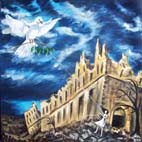Legato continues to spread its message. Despite the extensive newspaper, internet and television advertising in the province in April and May, the ongoing interest in Legato continuing into August proves that the best advertising is always word of mouth. Visitors are continuing to book appointments to see the exhibition over the relentlessly hot summer, and I am sure that is not because the gallery is a cool oasis in a scorched land. Recently while in New Zealand I received a phonecall from Italy, from a repeat visitor who had requested another viewing of Legato and wanted to comment on the different emotional power of the exhibition in the new venue.
Here in New Zealand three veteran soldiers looked at the exhibition photos and remembered, chatted, discussed many aspects of their time in Italy, and expressed their appreciation of the Cassino exhibition. Fingers lingered on the photograph showing Merv Appleton's work, the grave marked with the rifle having personal meaning for each of them.
A caller from Wellington shared with me comments from the Maori community who were grateful that their fallen were remembered in the exhibition. And so it goes on. It is now almost three months since the opening and it is still being discussed both in New Zealand and in Italy.
Another visit, where friends were talking about an article in the Waikato Times featuring Sarah Scott's contribution to Legato, saw a very animated and wide-ranging discussion about war, peace, and the current situation in Afghanistan. Dave Fowell's work was the most appropriate to discuss in that context, and it continues to spread its message from its lofty home in the historic Italian village. The conversation was passionate, and the word that stays with me from that conversation is "avarice". Our hostess very emphatically attributed the power struggles causing conflict to greed, unequal distribution of resources and love of power.
Now that New Zealand has lost a soldier in Afghanistan on active duty it is timely to remind ourselves that commemoration and respect is not enough. To truly honour our fallen we must not allow their sacrifices to be in vain. Those artists who choose to work for peace must make that step, from the exhibition at Cassino, to "making work that reflects today's conflicts, today's victims, today's political status." (author, Legato depliant, 2010). One "artist" doing exactly this is Lucy Adlington, in her novel for teenagers based on the Battle of Cassino, Burning Mountain. Others include New Zealanders Glenda Kane and Lisa Allen with their sensitively illustrated and poignant story, Anzac Day Parade. These artists and writers are using their time, talents, skills and creativity with real purpose, and in doing so are truly making a difference.
Another book that must be mentioned is Greg Mortenson's Three Cups of Tea. One person with drive and vision really can change lives.
Subscribe to:
Post Comments (Atom)












Changing hats... a review of Burning Mountain.
ReplyDeleteThe Next Children’s Classic
It is not often that a novel written for young readers grips and holds the adult reader from start
to finish. L J Adlington’s Burning Mountain is one that does. Spanning countries, generations
and wars past and present, this deceptively simple story is destined to become a classic novel for
teenagers.
Moving between modern England and wartime Italy, the unfolding wartime drama and modern
mystery can be read on many levels. The seamless intertwining of past and present, the subtle mix
of fact and fantasy and the complexity of the levels of message within the story make this novel not
only an ideal text for classroom study, but also a powerful and contemporary contribution towards
international understanding and peace.
Accidentally locked out in the rain, Denise and Craig seek refuge next door. An uneasy
friendship is formed with their elderly neighbours who share an intriguing story with them.
The repeated request is not clear. What did the crazy old lady next door want Denise to do?
The life and death issues that the children face as the tale unfolds provide ample opportunity
for classroom discussion. The mystery from the past draws out lessons from WWII and ties
them firmly to the present realities of the children’s life as they think of their brother fighting in
Afghanistan.
Wartime social, ethical and political issues emerge as the young Vittoria and Erich face their
challenges, differences, hopes and fears. When survival, rather than victory, becomes the aim, lines
between friend and foe are blurred.
While the younger reader is given more obvious clues to follow and switches in time are marked
by changing typefaces, the more sophisticated reader is given subtle hints and a sprinkling of Latin,
German and Italian phrases to challenge without disrupting the story. A complex multi-levelled
approach to solving the mystery can be found on every page, sometimes to be recognised only on a
second look as the storyline pulls the reader in eager anticipation quickly through the pages.
Modern social problems don’t escape the attention of this talented writer as she exposes the realities
of suburban life. Overriding all of this though is the message that war is not something that happens
to other people in far away places. The reader is reminded that while the Battle of Cassino veterans
who once were enemies meet in friendship, peace and reconciliation remains only a distant dream in
many parts of the world today.
Proving that truth can be stranger than fiction, this well researched novel teaches as much as it
enthrals. From an erupting volcano to a scruffy ragamuffin dog, each element has its place. Fast
moving, colourful, with just enough hint of romance and empathy to soften the brutality of war,
Burning Mountain leaves the reader challenged yet satisfied.
J K Scott MFA (Hons) P G Dip SNRT (Dist), BA, TTC.
Education Consultant, co-author of Listening and Speaking, English in the New Zealand
Curriculum and former teacher of English and Media Studies in New Zealand secondary schools.